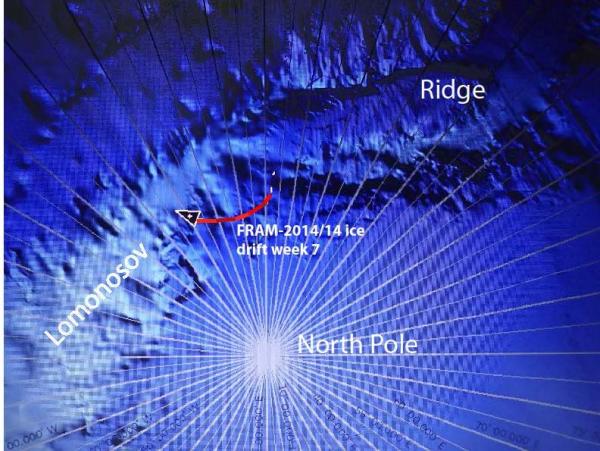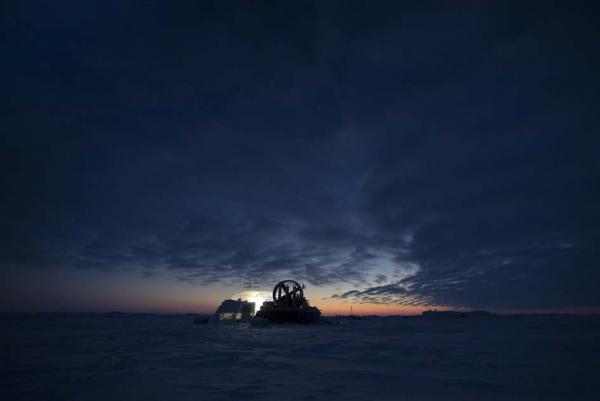(13- 20 Oct. 2014)
Ice drift
The ice camp moved about 20 nautical miles (37 km) during the week (see picture). A strong high pressure cell covered the whole Arctic Ocean during the week until Saturday when our location started to feel the effect of a low pressure arriving from east of Svalbard. In the high pressure situation, the ice drift was towards east and parallel to Lomonosov Ridge. It turned southeast and across the Lomonosov Ridge when the low pressure arrived. This suddenly gave us new opportunities - a gift in spite of the adversities associated with low pressure passages such as high winds and blowing snow.
Sea ice dynamics
Our environment involves a spectrum of physical processes operating on time scales ranging from seconds to millions of years. Formation and destruction of sea ice are parts of this picture. The activity at the FRAM-2014/15 ice camp this week was dominated by fighting the effects of sea ice dynamics; cracking, shear motion, subduction and pressure ridge formation, we had it all. Since sea ice represents an elastic plate overlying a fluid, sea ice dynamics represents an attractive analogue on a readily observable time scale for the interaction between the "rigid" geologic plates which forms the Earth's surface. Certainly, an attractive analogue for a desk scientist, but the attraction gets partly lost when you have your "boots on the ice" dealing with the consequences of sea ice dynamics.
On Monday morning, Audun observed a 10 cm wide crack that went straight through the middle of the deserted ice hangar (see picture). By Thursday, the crack had become 7 meter wide and the eastern half of the hangar had moved about 20 meters along the direction of the crack. Our current operation is about 35 meter away to the west of the crack. At the same time, another crack opened on the other side of the hovercraft the same distance away and widened to a few meter. Forty meter to the south of the hovercraft, ice belonging to the floe we were sitting on was being thrust under ice to the south and a 3 meter high pressure ridge formed on Thursday. Since then, there has been no ice motion in our immediate area. We evaluated the situation and decided to stay where we are for the time being. We are currently shooting seismics which is an around the clock operation and bi-hourly surveillance of the ice conditions in the surroundings is part of the routine.
All ice deformation processes are relatively slow. In the fast case, a crack may become half a meter wide in about 15 minutes. The potential damage is rupture of cables, but it does in no way represent a life threatening situation. Anything that directly affects the hovercraft is noticed instantly and we can relocate within minutes. The need to move away from a crack is most often not immediate, but a longer tern consideration. Local ice divergence may later turn to ice convergence and the thin and weak ice of a refrozen lead will then be the site of pressure ridge formation. Continued pressure ridge formation may ultimately consume part of an ice floe and whatever items left on the floe.
Sea ice dynamics is a fundamental process of the sea ice cover. Undisturbed sea ice reaches a thickness of about 2.5 meter by thermodynamic processes. If the ice is much thicker, it is because it has been involved in ice deformation during its life time. If you want to do science from drifting sea ice, you do that with the full knowledge that sea ice deformation may involve your location sooner or later, even several times. A deformation event at your location is not an unforeseen disaster, but the consequence of a calculated risk you must be prepared for. This time, we lost the ice hangar and the work invested in the gamble, but lessons were learned.
Science
As stated in earlier reports, the autonomous oceanographic instruments which include an acoustic Doppler depth profiler (0-500 m) and two current meters hanging from the ice (800 and now 1050 m depth), are running. The surface instruments are the weather station and instruments for measuring radiation fluxes. Ocean depth is measured by a drifting array of five echo sounders over a 6 km distance. We have problems with weak output power from the camp echo sounder giving no bottom return in deep water. However, water depth information at the camp is obtained from the seismic data. The seismic reflection measurements run well.
The influence of the low pressure arriving from Svalbard changed the ice drift from being parallel to the Lomonosov Ridge to across the ridge. By late Sunday night, the water depth had shallowed from 3300 meter to 2600 meter. We are shooting seismic and the bottom dredge is out.
The crack which opened through the ice hangar passed about 5 meters from the thermistor string. We therefore decided to relocate the string and started to pull it up on Thursday. In the process, we discovered that our hydrophone would soon be lost to an advancing pressure ridge and had to deal with the latter problem immediately. On the third attempt, we managed to melt the hydrophone out on Friday when the site was 2 meter away from the advancing pressure ridge. Subsequently, the thermistor string was redeployed, the highest thermistor being 1.3 m below the underside of the ice.
On Monday, we deployed a GoPro camera in a pressure case and lights mounted on a sled to obtain video shots of the seabed at 2650 meter depth below the ice camp. We obtained useful footage, but the field of view is limited as one of the lights failed. A short video segment is attached to this report.
Other activities
No signs of animal life was been observed during the week. However, we had visitors in the form of a submarine which surfaced about 3 nautical miles from our camp. Our attempt to visit failed as the vessel of unknown identity got submerged at a distance less than 100 meters away from us.
We need a head lamp to do any work outside the hovercraft. On days with overcast, we have complete darkness, while on the rare clear days we are reminded of the sun by a red horizon (see picture).
Life is treating us well, except for the mercy less sea ice dynamics.
Yngve Kristoffersen & Audun Tholfsen
Daily reports
Monday 13 October.
Position: 89 04.5' N, 175 57' E, temperature - 17 C, air pressure 1021 hPa, wind 22 knots from NN E. Ice drift 0.4 knots towards North. Checked the radiation flux instruments after midnight. Sun time detector covered with rime and IR detector with snow. Shooting seismic reflection all day. At 1030 hours, Audun discovered a 10 cm wide crack in the ice right through the middle of the ice hangar. Two boxes of food needed to be moved away from the crack. We lowered a GoPro camera and lights mounted on a camera sled down to the bottom at 2650 meter depth and obtained video images of the sea floor.
Tuesday 14 October.
Position: 89 08,9' N, 177 35' E, temperature - 14 C, air pressure 1031 hPa, wind 11 knots from ENE. Ice drift 0.2 knots towards northnortheast. Stopped the airgun at 0517 hours, we had a new crack through the ice on the port side about 20 meter away from the hovercraft widening several meters. Another crack 10 cm wide is parallel and passes 5 meter away from the craft. Hovercraft maintenance all day - replaced broken lift fan belt. Also removed the four jack-up legs and placed the hovercraft on four pallets. Felt a jerk of the ice floe. Audun observed a single 3 meter high pressure ridge about 30 meter to the south of the hovercraft. We evaluated the ice situation and decided to wait it out.
Wednesday 15ctober.
Position: 8 17.6' N, 179 36' W, temperature - 9 C, air pressure 1031 hPa, wind 11 knots from ENE. Ice drift 0.3 knots towards east. We are drifting along the bathymetric contours of Lomonosov Ridge. Hovercraft maintenance all day; adjusting the lift fan belt. No ice activity observed.
Thursday 16 October
Position: 89 19' N, 174 51' W, temperature - 8 C, air pressure 1036 hPa, wind 5 knots from E. Ice drift 0.1 knots toward east. Started recovery of the thermistor string as it is only 5 meter away from a crack that has widened 3 meters. The thin ice on refrozen leads are likely sites of future pressure ridge formation. Having recovered half (150 m), we discovered that the hydrophone was about to be consumed by the pressure ridge south of the hovercraft. Started to melt out the hydrophone, but was not successful. The 12 kHz echo sounder is giving us problems with weak or no bottom returns - recovered the transducer. In the evening. we spotted lights at a distance. Turned out to be a submarine at the surface in position: 89 17.5' N, 172 42.9' W. We were not able to identify it.
Friday 17 October.
Position: 89 20.6' N, 168 43' W, temperature - 13 C, air pressure 1036 hPa, wind 3 knots from NE. Ice drift 0.15 knots towards east. Was finally able to recover the hydrophone. Redeployed the 300 meter long thermistor string in the vicinity of the radiation flux instrument. The radiation flux instruments have been without power for several days. Laid out a cable across the lead and started charging. Cleaned all detectors. Also the weather station was completely covered with frost, cleaned all detectors. A small crack is going in between the guide wires, but no significant movement seen.
Saturday 18 October.
Position: 89 20.4' N, 164 41' W, temperature - 13 C, air pressure 1034 hPa, wind 6 knots from the SE. Ice drift 0.2 knots towards east. Shooting seismic all day. Audun moving food box away from the large crack (7 m wide).
Sunday 19 October.
Position: 88 18.7' N, 157 08' W, temperature - 17 C, air pressure 1028 hPa, wind 12 knots from ESE. Ice drift 0.3 knot towards ESE (back across Lomonosov Ridge). Blowing snow all day. Acquiring seismic reflection data all day. The dredge is out with 3000 meter Kevlar in anticipation of shallower water early Monday morning.

FRAM-2014/15 drift track (red) 13-20 October 2014.

An ice crack going right through the middle of the ice hangar. Photo: Audun Tholfsen

At 89 degrees North, the difference in sun elevation is about 1 degree between mid-day and mid-night which makes the difference in light conditions, minor. On days with overcast, it is completely dark while we are reminded about the presence of the sun on relatively clear days. To the left of the hovercraft is the lit work tent behind a lee wall of snow blocks. The walls of the ice hangar to the right.
Photo: Audun Tholfsen
